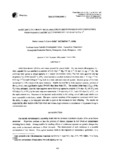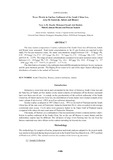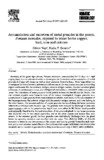Resistance to a heavy metal mixture in Oreochromis niloticus progenies from parents chronically exposed to the same metals

View/Open
Date
1995Page views
561Metadata
Show full item recordCited times in Scopus
- Citations
- CrossRef - Citation Indexes: 8
- Scopus - Citation Indexes: 11
- Captures
- Mendeley - Readers: 12
Share
Abstract
Adult Oreochromis niloticus were mass spawned in concrete tanks. The one-month old progenies (F1) were exposed for two months to a mixture of 0.01 mg L−1 Hg, 0.1 mg L−1 Cd and 1.0 mg L−1 Zn. The survivors were grown to sexual maturity in a natural environment (lake). The fish were spawned and the progenies (F2) of the exposed F1 (EF1) were exposed to another mixture of the three metals: 3.0 mg L−1 Zn, 0.30 mg L−1 Cd and 0.01 mg L−1 Hg, both in a static and static-renewal system. Another group of F2 from unexposed F1 (UF1) received the same treatment. Results showed that in both exposure systems, survival of the F2 of EF1 was significantly higher (P<0.05) than those from UF1. The medial lethal time (LT50) of the F2's were estimated from the time-response curve following regression analysis: 5.16 days (F2 of UF1) and 9.03 days (F2 of EF1) in the static exposure experiment; 3.34 days (F2 of UF1) and 5.52 days (F2 of EF1) in the static-renewal run. Exposure of the parental stock resulted in the culling out of individuals which were more susceptible to the heavy metals. The more resistant members of the population (survivors) which have the ability to adapt to the toxicants were able to pass on the resistance to their offspring. The results are supported by other studies in the field which demonstrate high resistance in populations of organisms living in contaminated sites.
Description
Poster presented at the Fifth International Symposium on Genetics in Aquaculture, June 19–25, 1994, Halifax, Nova Scotia, Canada.
Suggested Citation
Cuvin-Aralar, M. L. A., & Aralar, E. V. (1995). Resistance to a heavy metal mixture in Oreochromis niloticus progenies from parents chronically exposed to the same metals. Chemosphere , 30(5), 953-963. https://doi.org/10.1016/0045-6535(94)00001-B
Subject
Collections
- AQD Journal Articles [1248]
Related items
Showing items related by title, author, creator and subject.
-
Trace Metals in Surface Sediment of the South China Sea, Area II: Sarawak, Sabah and Brunei
Shazili, Noor A. M.; Rashid, Mohamed Kamil Abd; Husain, Mohd Lokman; Rosnan, Yaakob (Training Department, Southeast Asian Fisheries Development Center, 1999)The trace metals composition of surface sediment of the South China Sea off Sarawak, Sabah and Brunei were measured. Total metal concentrations in the 63 ?m fraction are reported in this study. For the pre-monsoon cruise, ... -
Trace Metal Concentrations and Distributions in Sea Water of the South China Sea, Area II: Sabah, Sarawak and Brunei Darussalam
Utoomprurkporn, Wilaiwan; Snidvongs, Anond (Training Department, Southeast Asian Fisheries Development Center, 1999)Water samples off Sabah, Sarawak and Brunei Darussalam were collected during July–August 1996 and May 1997 and analyzed for dissolved and particulate cadmium, copper, iron, lead and nickel. Dissolved metals were coprecipitated ... -
Accumulation and excretion of metal granules in the prawn, Penaeus monodon, exposed to water-borne copper, lead, iron and calcium
Vogt, Günter; Quinitio, Emilia T. (Elsevier, 1994)Juveniles of the giant tiger prawn, Penaeus monodon, were exposed for 10 days to 1 mg/l copper, lead, iron or calcium in order to investigate the formation and accumulation of metal granules in major soft tissues as well ...




